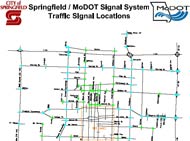8/18/2007
Missouri: Longer Yellows Eliminated Profit, So City Shortens Yellow TimesSpringfield, Missouri to move red light cameras to locations with shortened yellows to increase profitability.

Springfield, Missouri found that lengthening the yellow signal warning time at intersections that had previously been selected for the city's new red light camera program has now eliminated profit from the system. The city has decided to address this problem by moving its cameras to intersections where the yellow warning time has been shortened by at least half-a-second.
The signal shortening took place in February at 105 state-owned intersections as part of what the city called a "standardizing" of signal times. The yellow time was also increased by 0.5 seconds at 136 city-owned intersections -- including Battlefield and National Avenue, the location of Springfield's only currently active red light camera. As a result of the lengthening, the first 45 days of ticketing yielded a mere fifty-two $100 citations -- falling short of the 68 required before the location would become profitable.
That is why the city is going back on a previous promise to install the first five red light cameras only at city-owned intersections, where the yellow time was increased. Lasercraft, the for-profit company that operates the program, is "re-testing" intersections, according to the Springfield News-Leader. This testing is designed to find the profitable intersections which will be the state-owned locations where yellow times were shortened.
During a city council meeting last October, Assistant Director of Public Works Earl Newman explained why he shortened the yellow signals. He said he was, "concerned that many individuals run the light if the light remained yellow too long." This statement runs contrary to the findings of a 2005 Texas Transportation Institute study, that found a one-second reduction in yellow time resulted in a 100% increase in the number of violations (Table 6-2).


